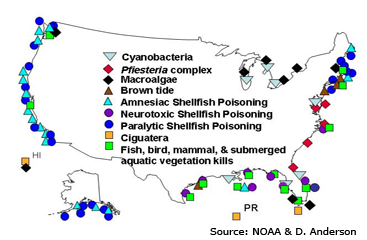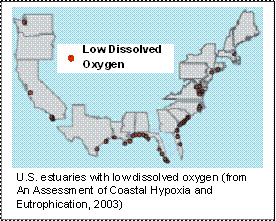You are here: Home › Stressors › Extreme Events › Harmful Algal Blooms › HABHRCA
HABHRCA
The Harmful Algal Bloom and Hypoxia Research and Control Act authorizes funding for research on HABS and hypoxia to advance scientific understanding and our ability to detect, assess, predict, control, and mitigate events. The legislation also mandates generation of FIVE written reports to assess the current state of research on and response to harmful algal blooms and hypoxia.
Click here for a pdf version of the HABHRCA fact sheet
Introduction

Both Congress and the Administration have recognized harmful algal blooms (HABs) and hypoxic events (severe oxygen depletion) as some of the most complex phenomena currently challenging management of aquatic and marine ecosystems. Virtually every coastal state has reported recurring blooms, and a recent national assessment revealed that over half of our Nation's estuaries experience hypoxic conditions. See the HAB Overview page for more on HAB impacts and the Hypoxia and Nutrient Pollution Overview page for more on hypoxia.

Scientific understanding of harmful algal blooms (HABs) and hypoxic events (severe oxygen depletion) has progressed significantly since the early 1990's, but major impediments still remain for prediction, control and mitigation of these complex phenomena. Practical and innovative approaches to address eutrophication, hypoxia and HAB's in US waters are essential for management of aquatic ecosystems and to fulfill a stronger investment in the health of the coasts and oceans called for by the U. S. Ocean Action Plan and recent reports on ocean policy. Recognizing this need, in 2004 Congress reauthorized and expanded the Harmful Algal Bloom and Hypoxia Research and Control Act of 1998 (HABHRCA, Public Law 108-456,) by passing the Harmful Algal Bloom and Hypoxia Amendments Act of 2004 (HABHRCA 2004, Public Law105-383).
The Interagency Task Force on Harmful Algal Blooms and Hypoxia
HABHRCA called for the reestablishment of the Interagency Task Force, who will oversee the production of several mandatory assessments and reports. The Joint Subcommittee on Ocean Science and Technology (JSOST) established the Interagency Working Group on Harmful Algal Blooms, Hypoxia, and Human Health (IWG-4H) to assume the role of the Interagency Task Force. Representatives of the Department of Commerce and the Department of Human and Health Services serve as co-chairs of the IWG-4H.
Plans and Reports called for by HABHRCA 2004
The following assessments and plans were mandated by the HABHRCA 2004 legislation. Several of these reports were due to Congress within one year of enactment. The IWG 4H, however, modified the dates for submission to the Joint Subcommittee on Ocean Science and Technology as indicated below. For details and current status of individual reports, click below.
Reports and Plans |
Due Date |
||
|---|---|---|---|
Legislated |
Modified |
Report Status | |
Dec., 2005 |
Dec., 2006* |
Published (click here for .pdf)
|
|
Dec., 2005 |
Dec., 2007** |
Undergoing interagency approval | |
Dec., 2006 |
Dec., 2006 |
Published online (Click here for PDF) | |
Dec., 2006 |
Dec., 2007 |
Undergoing interagency approval | |
after Dec., 2006 |
Nov., 2008 |
In preparation | |
* Interim Prediction
and Response Report |
|||
Past Plans and Reports called for by HABHRCA 1998
The 1998 HABHRCA legislation originally established the Interagency Task Force to develop four assessments and plans. These plans (listed below) were produced as a collaborative effort that included Federal and State agencies, Tribes, and research institutions and have guided HAB and hypoxia research:
- National Assessment of Harmful Algal Blooms in US waters, 2000
- Integrated
Assessment of Hypoxia in the Northern Gulf of Mexico, 2000
- Action Plan for Reducing, Mitigating, and Controlling Hypoxia in the Northern
Gulf of Mexico, 2001
- An Assessment of Coastal Hypoxia and Eutrophication in US Waters, 2003
Current Research Programs on HABs and Hypoxia
HABHRCA also authorizes funding to be appropriated to the Secretary of Commerce for research, education, and monitoring activities related to the prevention, reduction, and control of harmful algal blooms and hypoxia.
The following are examples of ongoing research programs that support interdisciplinary research studies to address the issues of HABs and hypoxia:
- Ecology and Oceanography of Harmful Algal Blooms (ECOHAB)— a multi-agency partnership between the U.S. Environmental Protection Agency (U.S. EPA - search ECOHAB), National Aeronautics and Space Administration (NASA), National Science Foundation (NSF), NOAA's Center for Sponsored Coastal Ocean Research (CSCOR) and the Office of Naval Research (ONR)
- Monitoring and Event Response for Harmful Algal Blooms (MERHAB)
- Coastal Hypoxia Research Program (CHRP)
- Interagency Research Efforts on Gulf of Mexico Hypoxia
- Northern Gulf of Mexico Program (NGOMEX)
- EPA Gulf of Mexico Program
- USGS Hypoxia in the Gulf of Mexico
Regional fact sheets are available in pdf format below:
- Harmful Algal Blooms and Hypoxia in the Gulf of Mexico
- Harmful Algal Blooms and Hypoxia in the Great Lakes
- Harmful Algal Blooms and Hypoxia in the Northeastern United States
- Harmful Algal Blooms and Hypoxia in the Pacific Coast Region
- Harmful Algal Blooms and Hypoxia Research in Washington State
Conferences and Workshops Related to HABHRCA Reports
2005
- International Symposium on Cyanobacterial Harmful Algal Blooms (ISOC-HAB). Research Triangle Park, NC, September 6-10, 2005
- Research, Development, Demonstration, and Technology Transfer Workshop, Woods Hole, MA, June 25-27, 2008
2007
- Research, Development, Demonstration, and Technology Transfer Workshop, Woods Hole, MA, June 25-27, 2007
Pertinent Documents
- Harmful Algal Research and Response: A National Environmental Science Strategy (HARRNESS) 2005-2015
The 2005 National Plan for Algal Toxins and Harmful Algal Blooms provides the consensus of the U.S. scientific and management community on accomplishments and impediments in harmful algae research. This report also puts forth priorities that will guide HAB research for the next decade.
- Harmful Algal Research and Response: A Human Dimensions Strategy, released in 2006, provides a detailed implementation plan for human dimensions research necessary to reduce the public health, sociocultural, and economic impacts of harmful algal blooms. It is the first report to expand upon recommendations of the HARRNESS report.
- Cyanobacterial Harmful Algal Blooms: State of the Science and Research Needs The workshop report from the ISOC-HAB symposium was published in April 2008. The Scientific Assessment of Freshwater Harmful Algal Blooms is based, in large part, on this interagency workshop report.
Informational Websites
To find out more about Hypoxia:
To find out more about HABs:
- Visit the CSCOR HAB Overview Page
- The Harmful Algae Page from Woods Hole Oceanographic Institution

